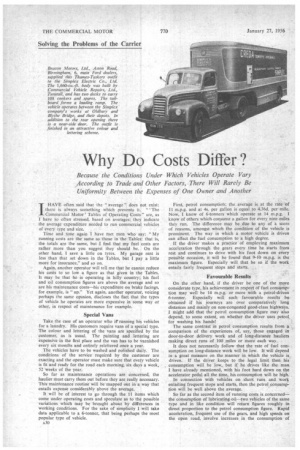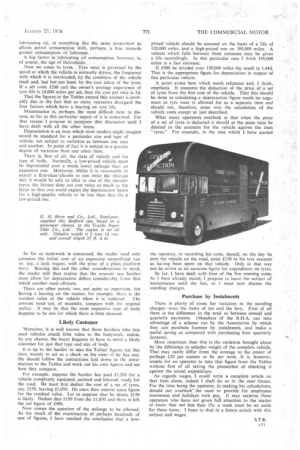Why Do Costs Differ?
Page 32

Page 33

If you've noticed an error in this article please click here to report it so we can fix it.
Because the Conditions Under Which Vehicles Operate Vary ,According to Trade and Other Factors, There Will Rarely Be Uniformity Between the Expenses of One Owner and Another
IHAVE often said that the "average" does not exist: there is always something which prevents it. "'The Commercial Motor' Tables of Operating Costs" are, as I. have so often stressed, based on averages: they indicate the average expenditure needed to run commercial vehicles of every type and size.
Time and time again 1 have met men who say: " My running costs are the same as those in the Tables.: that is, the totals are the same, but I find that my fuel costs are rather more than you suggest they should be. On the other hand, I save a little on tyres. My garage rent is less than that set down in the Tables, but I pay a little more for insurance," and so on.
Again, another operator will tell me that he cannot reduce his costs to so low a figure as that given in the Tables. It may be that he is operating in hilly country; his fuel and oil consumption figures are above the average and so are his maintenance costs—his expenditure on brake facings, for example, is "up." Yet again, another operator, voicing perhaps the same opinion, discloses the fact that the types of vehicle he operates are more expensive in some way or other, in respect of maintenance for example.
Special Vans Take the case of an operator who i? running his vehicles for a laundry. His customers require vans of a special type. The colour and lettering of the vans are specified by the customer, as is usual. The painting and lettering are expensive in the first place and the van has to be varnished every six months and entirely relettered once a year.
The vehicles have to be washed and polished daily. The conditions of the service required by the customer are exacting and the operator must make sure that every vehicle is fit and ready for the road each morning, six days a week, 52 weeks of the year. . .
So far as maintenance operations are concerned, the haulier Must carry them out before they are really necessary. This maintenance routine will be mapped out in a way that entails expense considerably above the average.
It will be of interest to go through the 11 items which come under operating costs and speculate as to the possible variations which may be brought about by differences in working conditions. For the sake of simplicity I will take data applicable to a 6-tonner, that being perhaps the most popular type of vehicle.
a30
First, petrol consumption; the average is at the rate of 11 m.p.g, and at 4s. per gallon is equal to 4.36d, per mile.. Now, I know of 6-tonners which operate at 14 m.p.g. I know of others which consume a gallon for every nine miles they run. The difference may be due to any of a score of reasons, amongst which the condition of the vehicle is prominent. The way in which a motor vehicle is driven can affect the fuel consumption to a high degree.
If the driver makes a practice of employing maximum acceleration through the gears every time he starts from rest and continues to drive with his foot down on every possible occasion, it will be found that 9-10 m.p.g. is the maximum figure. Especially will that be so if the work entails fairly frequent stops and starts.
Favourable Results On the other hand, if the driver be one of the more considerate type, his achievement in respect of fuel consumption may well be 14 m.p.g. or more with a petrol-driven 6-tonner. Especially will such favourable results be obtained if his journeys are over comparatively long distances and mainly on non-congested good-class highways. I might add that the petrol consumption figure may also depend, to some extent, on whether the driver uses petrol_ for washing his hands!
The same contrast in petrol consumption results from a comparison of the experiences of, say, those engaged in door-to-door delivery work and of long-distance hauliers making direct runs of 100 miles or more each way.
It does not necessarily follow that the rate of fuel consumption on long-distance work will be low. It will depend in a great measure on the manner in which the vehicle is driven. If the driver keeps to the legal limit then his consumption will be low, but if he drives like the man I have already mentioned, with his foot hard down on the accelerator pedal all the time, his consumption will be high.
In connection with vehicles on short runs and work entailing frequent Stops and starts, then the petrol consumption will be well above the average.
So far as the second item of running costs is concerned— the consumption of lubricating oil—two vehicles of the same type and in like condition will return figures roughly in direct proportion to the petrol consumption figure. Rapid acceleration, frequent use of the gears, and high speeds on the open road, involve increases in the consumption of lubricating oil, in something like the same proportion as affects petrol consumption with, perhaps, a bias towards greater consumption of lubricant.
A big factor in lubricating oil consumption, however, is, of course, the age.Of thekvehicle.
Now we come to tyres. Tyre wear is governed by the speed at which the vehicle is normally driven, the frequency with which it is overloaded, by the condition of the vehicle itself and, last but not least, by the care taken of the tyres. If .a set costs £200 and the owner's average experience of tyre life is 24,000 miles per set, then the cost per mile is 2d.
That the figures in the Tables exceed this amount is probably due to the fact that so many operators disregard the four factors which have a bearing on tyre life.
Maintenance is, perhaps, the most difficult item to discuss, so far as this particular aspect of it is concerned. For that reason I propose to postpone that discussion until I have dealt with all the other items.
Depreciation is an item which most readers might imagine would be standard for a particular size and type of vehicle, not subject to variation as between one user and another. In point of fact it is subject to a greater degree of variation than any other item.
There is, first of all, the class of vehicle and the type of body. Normally, a low-priced vehicle must be depreciated over a much lower mileage than an expensive one. Moreover, whilst it is reasonable to expect a first-cIass•chassis to run twice the mileage that it would be safe to allot to one of the cheaper types, the former does not cost twice as much as the latter so that one could expect the depreciation figure for a high-quality vehicle to be less than that for a low-priced one.
So far as bodywork is concerned, the reader need only compare the initial cost of an expensive streamlined van or, say, a tank wagon, with the price of a plain platform lorry. Bearing this and the other considerations in mind, the reader will then realize that the amount one haulier must allow for depreciation differs considerably from that which another must allocate.
There are other. points, too, not quite so important, but having a bearing on the matter; for example, there is the residual value of the vehicle when it is replaced. The amount need not, of necessity, compare with the original outlay. It may be that the most expensive type of body happens to be one for which there is little demand.
Likely Customer
Moreover, it is well known that those hauliers who buy used vehicles attach little value to the bodywork, unless, by any chance, the buyer happens to have in mind a likely customer for just that type and size of body.
It is up to the haulier to take the Tables' figures for this item, mainly to act as a check on his own—if he has any. He should follbw the instructions laid down in the introduction to the Tables and work out his own figures and see how they compare.
For example, suppose the haulier has paid £1,200 for a vehicle completely equipped, painted and lettered, ready for the road. He must first deduct the cost of a set of tyres, say, £150, leaving £1,050. He must then assume some figure for the residual value. Let us suppose that he thinks £150 is likely. Deduct that £150 from the £1,050 and there is left the net figure of £900.
Now comes the question of the mileage to be allowed. As the result of the examination of perhaps hundreds of sets of figures, I have reached the conclusion that a low
priced vehicle should be assessed on the basis of a life of 120,000 miles, and a high-priced one on 300,000 miles. ' A vehicle which falls between these extremes may be given a life accordingly. In this particular case I think 150,000 miles is a fair estimate.
If £900 be divided over 150,000 miles the result is 1.44d. That is the appropriate figure for depreciation in respect of this particular vehicle.
A point arises here which needs reference and, I think, emphasis. It concerns the deduction of the price of a set of tyres from the first cost of the vehicle. That this should be done in calculating a depreciation figure needs no argument as tyre wear is allowed for as a separate item and should not, therefore, enter into the calculation of the vehicle costs except as just described.
What many operators overlook is that when the price of a set of tyres is deducted it should at the same time be debited in the accounts for the vehicle against the item "tyres." For example, in the case which I have quoted
the operator, in recording his costs, should, on the day he puts the vehicle on the road, enter £150 in his tyre account. as having been spent on that vehicle. Only in that way can he arrive at an accurate figure for expenditure on tyres.
So far, I have dealt with four of the five running costs. As I have already stated, I propose to leave the subject of maintenance until the last, so I must now discuss the standing charges.
Purchase by Instalments
There is plenty of room for variation in the standing charges—even the items of tax and the levy. First of all there is the difference in the total as between annual and quarterly payments. (Members of the R.H.A. can take advantage of a scheme run by the Association by which they can purchase licences by instalments, and make a useful saving as compared with purchasing four quarterly licences).
More important than this is the variation brought about by the difference in unladen weight of the complete vehicle. That may easily differ from the average to the extent of perhaps £20 per annum or 8s. per week. it is, however, unsafe for an operator to take that figure from the Tables without first of all taking the precaution of checking it against the actual expenditure.
As regards wages, I could write a complete article on that item alone, indeed I shall do so in the near future. For the time being the operator, in making his calculations, should not overlook' theneed to provide for employees insurances and holidays with pay. It may surprise those operators who have not given full attention to the matter to know that not less than 15s. a week must be set aside for these items. I hope to deal in a future article with this subject and wages.




































































